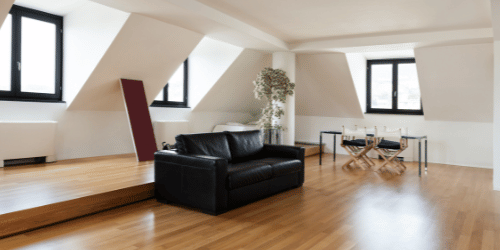From squeaky boards to water damage, understanding how to prevent and repair common flooring problems is crucial for any homeowner. In this comprehensive guide, we’ll walk you through essential strategies to ensure your floors remain beautiful and functional long after the renovation dust has settled.
Proper maintenance and timely repairs can extend the lifespan of your flooring. Let’s explore practical solutions for addressing scratches, dents, and cracks.
Scratches
Causes of Scratches
Common causes of scratches on laminate flooring include furniture movement, pet claws, and high heels. Furniture can easily scratch the surface when dragged or pushed across the floor, while pets running around can leave claw marks, and high heels can create dents and scratches due to their concentrated pressure. To prevent these scratches, use felt pads under furniture legs to reduce friction, place area rugs in high-traffic areas to protect the floor, and keep pet nails trimmed. Additionally, encourage people to avoid wearing high heels on laminate flooring to minimize potential damage.
Repair Techniques
To repair minor scratches on laminate countertops, you can use wood filler or touch-up markers. Start by cleaning the area, then apply wood filler to the scratch, smoothing it out with a putty knife and letting it dry before gently sanding it to level the surface. Alternatively, use a touch-up marker to color in the scratch and blend it with the surrounding area using a soft cloth. For deeper scratches, consider professional refinishing options where experts can sand down the surface and apply a new layer of laminate or a specialized refinishing product, ensuring a correct and long-lasting repair.
Prevention Strategies
To maintain scratch-free laminate floors, regular cleaning and protective measures are essential. Begin by sweeping or vacuuming frequently to remove dirt and debris that can cause scratches when walked on. For deeper cleaning, use a damp mop with a laminate-safe cleaner, ensuring you avoid excessive water that could damage the floor. Place mats at entryways to catch dirt and grit before they reach the floor, and consider using rugs in high-traffic areas for added protection. Apply furniture pads under the legs of chairs, tables, and other heavy objects to minimize friction and avoid dragging these items across the floor. Regularly trim your pets’ nails to prevent claw marks and encourage family members and guests to avoid wearing high heels on the laminate to reduce the risk of dents and scratches. By following these steps, you can keep your laminate floors looking pristine and extend their lifespan.
Dents
Identifying Dents
Dents in laminate flooring can come from various sources, such as dropped objects or heavy furniture. Dropped objects, especially heavy or sharp items, can create small, concentrated dents that mar the surface. Heavy furniture, when not properly supported or moved, can cause larger, more noticeable dents that affect a broader area. Addressing dents promptly is important to prevent further damage and maintain the floor’s appearance. Left untreated, dents can weaken the laminate and lead to additional issues like cracking or peeling. Quick repairs can help preserve the floor’s integrity and extend its lifespan.
Repair Methods
To lift minor dents in laminate flooring, you can use steam or a damp cloth. Place a damp cloth over the dent and apply heat with an iron set to medium, moving it in circular motions for a few minutes. The steam will cause the laminate to expand and lift the dent. For deeper dents, you might need to repeat the process a few times. For more severe dents, sanding and refinishing options are available. Lightly sand the affected area to smooth out the dent, then apply a matching laminate filler or a specialized repair kit. Once the filler is dry, sand it again to ensure a smooth surface and finish with a sealant to protect the repair. These techniques can help restore the appearance of your laminate flooring and prevent further damage.
Preventive Measures
To prevent dents in laminate flooring, take proactive measures like using furniture pads and avoiding heavy impacts. Place felt or rubber pads under the legs of all furniture to distribute weight evenly and reduce the risk of dents when items are moved or shifted. Avoid dropping heavy objects or allowing heavy furniture to rest on the floor without proper support. Additionally, be cautious with high heels and heavy footwear, as they can also create dents. By incorporating these preventive steps into your routine, you can help maintain the integrity and appearance of your laminate flooring, minimizing the likelihood of damage.
Cracks
Types of Cracks
Surface cracks and structural cracks in laminate flooring have different causes and implications. Surface cracks are superficial, affecting only the top layer and often resulting from impacts or abrasion. They are typically easier to repair with touch-up products or minor refinishing. Structural cracks, on the other hand, extend beyond the surface and affect the core or substrate of the laminate, usually due to improper installation, moisture damage, or significant impacts. These cracks are more serious as they can compromise the floor’s stability and durability, requiring more extensive repairs such as replacing damaged sections or addressing underlying issues. Understanding the significance of each type helps in choosing the right repair approach and maintaining the long-term health of your flooring.
Repair Approaches
To fill minor cracks in laminate flooring, you can use epoxy or wood putty. First, clean the crack to remove debris, then apply the epoxy or putty using a small applicator or putty knife. Smooth it out, wipe away any excess, and allow it to cure or dry according to the product instructions. For larger cracks, professional intervention may be necessary, as these often indicate more serious issues. A flooring specialist can assess the damage, perform extensive repairs, such as replacing sections, and address any underlying problems to ensure the floor’s structural integrity and appearance are restored effectively.
Avoiding Future Cracks
Factors such as humidity, subfloor preparation, and proper installation are crucial for maintaining laminate flooring. Humidity can cause the laminate to expand or contract, leading to gaps or warping. Proper subfloor preparation ensures that the surface is level, clean, and dry, providing a stable foundation for the laminate. Correct installation, including appropriate spacing and acclimation of the laminate, helps prevent issues like buckling or gaps. Preventive maintenance, such as regular cleaning, using furniture pads, and controlling humidity levels, plays a key role in preserving the floor’s appearance and extending its lifespan. Addressing these factors and maintaining your laminate flooring properly can help ensure its durability and visual appeal over time.
Flooring Maintenance Tips
Regular Cleaning
Routine cleaning is crucial to prevent dirt and debris from scratching laminate flooring, as these particles can act as abrasives and cause damage over time. Practical cleaning methods include vacuuming with a soft brush attachment to remove loose dirt, sweeping with a soft-bristled broom for daily upkeep, and damp mopping with a laminate-safe cleaner to tackle stubborn grime. These methods help maintain the floor’s appearance and prevent scratches by keeping the surface free from harmful particles and excessive moisture. Regular cleaning ensures the longevity and visual appeal of your laminate flooring.
Protective Measures
In addition to using furniture pads, there are several other protective measures that can help preserve laminate flooring. Placing doormats at entryways is effective for capturing dirt and grit before they are tracked inside, significantly reducing the risk of scratches and abrasions. Area rugs placed in high-traffic areas provide extra cushioning and protect the floor from daily wear and impact. UV-resistant window coverings are also important, as they block harmful sunlight that can cause fading and deterioration of the laminate over time. These protective strategies, combined with routine cleaning, help maintain the appearance and durability of your laminate flooring, ensuring it remains in excellent condition for years to come.
Seasonal Considerations
Seasonal changes can affect laminate flooring due to fluctuations in humidity and temperature, with winter often causing the laminate to contract and develop gaps due to lower indoor humidity, and summer leading to expansion and potential buckling from higher humidity. To adjust maintenance routines, use a humidifier in winter to maintain consistent humidity levels and prevent contraction, while in summer, a dehumidifier or air conditioning can help manage excess moisture and reduce expansion. Regularly inspect for gaps or buckling and address them promptly to prevent further damage. By adapting your maintenance practices to seasonal changes, you can protect your laminate flooring and extend its lifespan.
Answering Common Questions
Q1 How can I prevent scratches on my hardwood floors?
A1 Regularly trim pet nails, use area rugs, and apply protective pads to furniture legs.
Q2 What’s the best way to fix a dent in laminate flooring?
A2 Use steam to raise the dent, then follow up with refinishing or replacement if needed.
Q3 Are cracks in tile floors a cause for concern?
A3 Surface cracks are common and can be repaired, but structural cracks require professional assessment.
The Impact of Humidity
Excessive humidity can exacerbate flooring issues. Monitor indoor humidity levels to maintain floor integrity.
Seeking Expert Advice
While DIY repairs are helpful, consult professionals for major issues or extensive damage. Pristine Luxury Remodeling is here to assist you on your flooring journey.
Conclusion
In this comprehensive guide, we’ve explored practical solutions for repairing common flooring issues such as scratches, dents, and cracks. Pristine Luxury Remodeling encourages homeowners in Prosper, TX, to take proactive steps to maintain their floors’ beauty and functionality. Remember these key points: prevention is crucial—regularly trim pet nails, use protective pads, and employ area rugs to avoid scratches and dents; timely repairs are important—address minor issues promptly to prevent them from worsening; and climate control matters—monitor humidity levels to safeguard your floors from expansion and contraction. Whether you have hardwood, laminate, or tile flooring, a little care goes a long way. Seek professional advice when needed, and let Pristine Luxury Remodeling be your partner in achieving flooring excellence.
Visit us at Pristine Luxury Remodeling
For more information and personalized guidance visit us at Pristine Luxury Remodeling, We specialize in providing exceptional remodeling services that elevate your space into a masterpiece of luxury.







